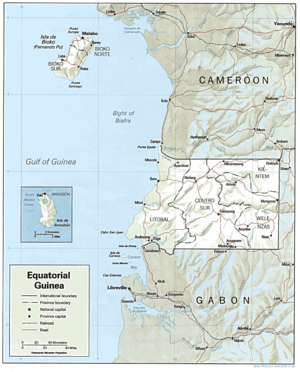Treaty of El Pardo (1778) facts for kids
| Treaty of Friendship, Guaranty and Commerce between Spain and Portugal. | |
|---|---|

The Río de la Plata basin, main area of dispute between Spain and Portugal
|
|
| Context | Spain and Portugal finalise boundaries in the Río de la Plata region, Spain gains territories in Equatorial Africa |
| Signed | 11 March 1778 |
| Location | Royal Palace of El Pardo near Madrid |
| Negotiators |
|
| Parties | |
The Treaty of El Pardo was an important agreement signed on March 11, 1778. It helped to end a long-running disagreement between Spain and Portugal. This disagreement was mainly about land in the Río de la Plata area. This region is now where Argentina and Uruguay are located.
The treaty confirmed that Spain would own Colonia del Sacramento. This city is now part of Uruguay. In return, Portugal gave up control of some key lands in Africa. These lands are now part of the country of Equatorial Guinea. Spain also agreed to leave some lands to the north. Most of these lands are now in the southern part of Brazil, in the state of Rio Grande do Sul.
Contents
Why Was the Treaty of El Pardo Needed?
For almost 300 years, Spain and Portugal argued about their borders. This was especially true in the Río de la Plata region. The problem started because they had different ideas about an old agreement called the Treaty of Tordesillas.
How Did Trade Disputes Lead to Conflict?
Portuguese traders often entered the Río de la Plata area. This allowed them to avoid Spain's rules on bringing goods into Spanish South America. In 1690, Portugal built a trading post called Colonia del Sacramento. It was right across the river from Buenos Aires. This place became a major spot for illegal trade.
What Previous Attempts Were Made to Settle Borders?
Spain and Portugal tried to fix their border issues with the 1750 Treaty of Madrid. However, King Charles III of Spain canceled this treaty in 1761.
Spain then joined France in the Seven Years' War in 1762. Their attempt to invade Portugal did not go well. But they did capture Colonia del Sacramento and some lands in what is now southern Brazil. Even though Spain had to give back Colonia del Sacramento in 1763, they kept the lands in Rio Grande. Spain argued these lands were actually theirs.
How Did the War of 1776–1777 End the Conflict?
Over the next ten years, Portugal took back Rio Grande. This led to an undeclared war. Then, a formal war started in 1776, known as the 1776–1777 Spanish–Portuguese War.
In February 1777, a large Spanish force captured Santa Catarina island. They then moved on to Colonia del Sacramento, which surrendered in July. The fighting stopped when King Joseph I of Portugal died in February 1777. His daughter, Maria I, who was born in Spain, asked for peace.
The First Treaty of San Ildefonso was signed in October 1777. It set up a group to mark the borders in the Río de la Plata region. The Treaty of El Pardo later confirmed these new borders.
What Did the Treaty of El Pardo Decide?
The Treaty of El Pardo confirmed the findings of the border group. Portugal officially gave Colonia del Sacramento to Spain. In return, Spain moved out of lands to the north.
New Rules for Trade and Territories
The treaty also included rules about trade. The most important rules were about tobacco and the Atlantic slave trade. Spain got back trading posts for the West African slave trade. These posts had been given up in an older agreement from 1479.
Spain gained the Portuguese islands of Annobón and Bioko (also known as Fernão Pó). They also got land on the mainland between the Niger River and the Ogoue River. These new Spanish lands were managed by the Viceroyalty of the Rio de la Plata, which was based in Buenos Aires.
What Happened After the Treaty?

Spain hoped the new border agreement would help its economy grow. However, a war with Britain from 1779 to 1783 made trade difficult. This war also led to high taxes to pay for it.
How Did the Colonies Gain Independence?
During the Napoleonic Wars, the connection between Spain's government and its colonies became weaker. Portugal took back some lands in 1801. Despite this, the colonists in South America successfully fought off British invasions in 1806 and 1807.
The Spanish American wars of independence happened between 1809 and 1829. These wars led to the independence of Spain's colonies in the Americas. The Viceroyalty of Río de la Plata broke apart during the Argentine War of Independence (1810–1818).
What Became of the African Lands?
The African lands given to Spain by the Treaty of El Pardo became the colony of Spanish Guinea. Portugal had not paid much attention to Annobón and Bioko. They had focused more on São Tomé.
As the transatlantic slave trade slowly ended in the 1800s, these islands became less valuable to Spain. In 1968, Spanish Guinea became the independent country of Equatorial Guinea.
See also
 In Spanish: Tratado de El Pardo (1778) para niños
In Spanish: Tratado de El Pardo (1778) para niños

